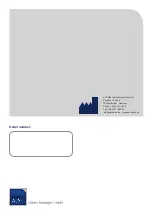
34
i
NOTE
- Clean the safety brakes and brake drums inside the rims with alcohol once a week
(more often if soiled). Observe the hazard information for the alcohol.
i
NOTE
- Observe the instructions of the cleaning agent manufacturer.
7.2 Checking brake linings / climbing feet linings and air pressure
7.3 Cleaning
Wipe off any soiling on all components with a mild household cleaner.
i
NOTE
- The minimum thickness of the brake linings (in the centre) is 1 mm. If the lining thick-
ness is less than 1 mm or if the linings are damaged: contact the manufacturer, the AAT field
service or a cer
tified partner.
i
NOTE
- If the linings of the climbing feet are worn or damaged: have both climbing feet re-
placed by the manufacturer, the AAT field service or a certified partner.
i
NOTE
- The air pressure in the tyres must be
3
.5 bar. Only then will the safety brakes work
properly. If the air pressure is too low: inflate the tyres. If the tyres are damaged: contact the
manufacturer, the AAT field service or a certified partner.
WARNING
- Check the safety brakes after cleaning (section 5.7).
WARNING
- Do not smoke while cleaning.
WARNING
- Use only moist cloths for cleaning. The cloths must not be wet.
No moisture shall reach the inner parts of the device.
CAUTION
- Keep the C120 away from sources of ignition.
CAUTION
- Do not use a high-pressure cleaner for cleaning.
Check the brake linings of the
safety brakes for damages
and wear on a regular basis.
Check the climbing feet lin-
ings for damages and wear on
a regular basis.
Check air pressure on a reg-
ular basis.
The red markings in figures 1 + 2 serve as an aid for checking the lining thickness.







































